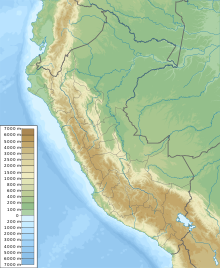| Salcantay | |
|---|---|
 View from the southwest. | |
| Highest point | |
| Elevation | 6,271 m (20,574 ft)[1][2][3][4] or 6,264 m (20,551 ft)[5][6] |
| Prominence | 2,540 metres (8,330 ft)[5][6] |
| Listing | Ultra |
| Coordinates | 13°20′01″S 72°32′40″W / 13.33361°S 72.54444°W |
| Geography | |
| Location | Cusco Region, Peru |
| Parent range | Vilcabamba, Andes[3][4][6][7][8] |
| Climbing | |
| First ascent | August 4, 1952, by Fred D. Ayres, David Michael Jr., W. V. Graham Matthews, George Irving Bell, Claude Kogan, M. Bernard Pierre |
| Easiest route | Northeast ridge: technical glacier/snow/ice climb (French grade AD)[4] |
Salcantay,[9] Salkantay or Sallqantay (in Quechua) is the highest peak in the Vilcabamba mountain range, part of the Peruvian Andes. It is located in the Cusco Region, about 60 km (40 mi) west-northwest of the city of Cusco. It is the 38th-highest peak in the Andes and the twelfth-highest in Peru. However, as a range highpoint in deeply incised terrain, it is the second most topographically prominent peak in the country, after Huascarán.

Salcantay's proximity to Machu Picchu makes trekking around it an alternative to the oversubscribed Inca Trail; this is known as the Salkantay trek.
- ^ This elevation is from a Peruvian military survey, quoted in the American Alpine Journal, 1973
- ^ INEI, Perú: Compendio Estadístico 2005, op. cit.
- ^ a b Encarta/Spanish, "Cordillera Vilcabamba" and "Salcantay", op. cit.
- ^ a b c Biggar 2005, op. cit.
- ^ a b Ferranti 2005, "Peru ultra-Prominences", op. cit.
- ^ a b c Peakbagger, "Salcantay, Peru", op. cit.
- ^ INEI, Perú: Compendio Estadístico 2005, op. cit., attaches three peaks including the Salcantay to the Cordillera Vilcanota instead of Vilcabamba, but this was identified as a typo, and all other sources disagreed. Details in the endnotes to article "List of mountains in Peru".
- ^ Rachowiecki 1991, op. cit.
- ^ Peru 1:100 000, Machupicchu (27-q). IGN (Instituto Geográfico Nacional - Perú).
